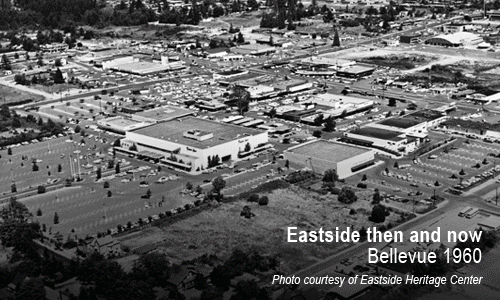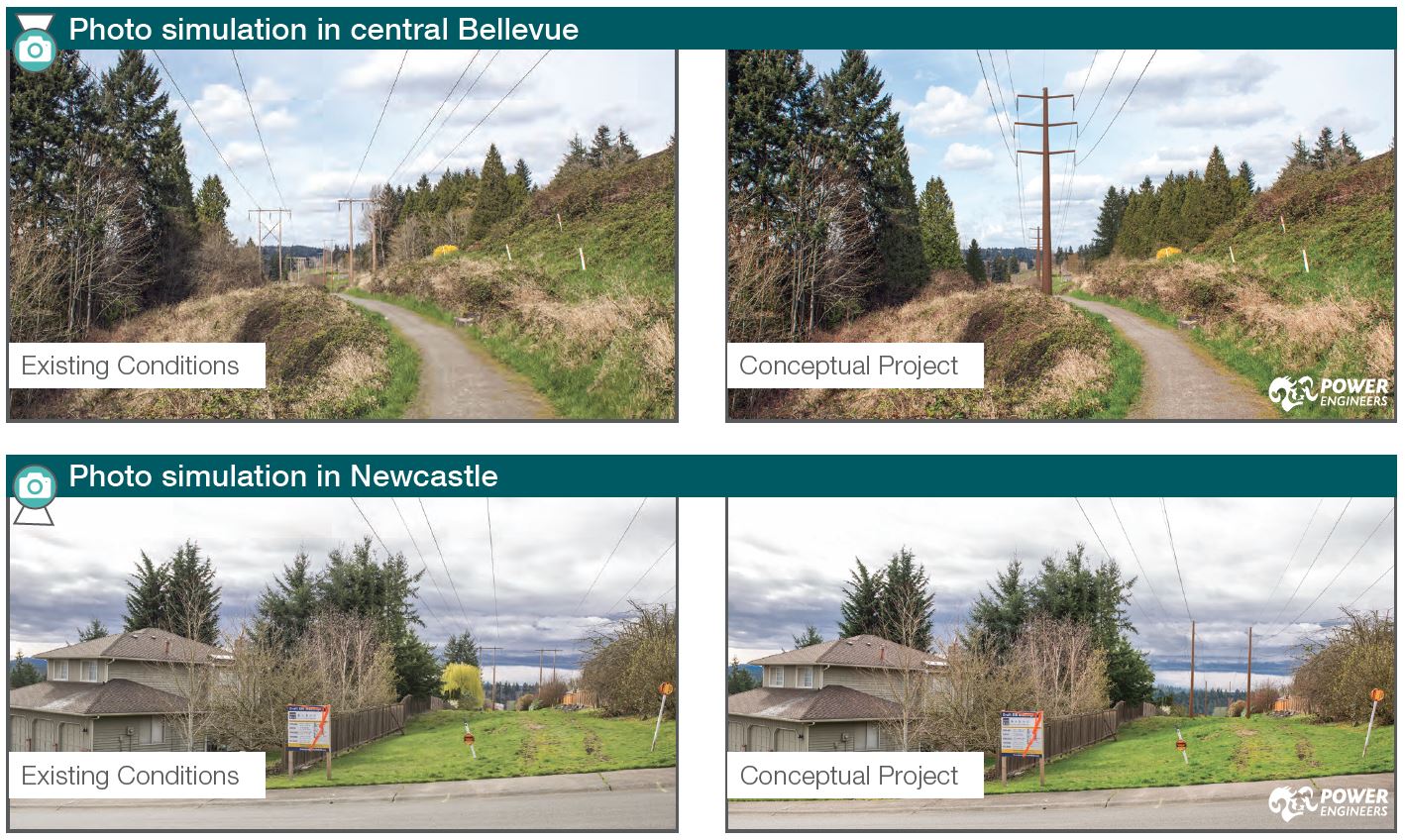Project Overview
The Energize Eastside project is building a new substation and upgrading approximately 16 miles of transmission lines within the existing corridor from Redmond to Renton. Combined with continued electric conservation, Energize Eastside will keep the lights on for homes and businesses in our Eastside communities for years to come.
Key facts
Click the facts below to learn more about Energize Eastside.
-
> The Eastside has grown and it's time for our infrastructure to catch up

The last major upgrade to the backbone of the Eastside’s electric grid was more than 50 years ago in the 1960s. Since then, our population has grown eight-fold and our economy relies on reliable power in ways that it did not 50 years ago. This growth will only continue. Projections by the Puget Sound Regional Council show the Eastside population will likely grow by another third and employment will grow by more than three-quarters over the next 25 years.
-
> Now is the time to upgrade
Studies projected that growth on the Eastside could cause demand for electricity to exceed the capacity of the backbone of the Eastside’s transmission system. In fact, our peak demand increased faster than modeled and our actual summer peak demand exceeded our load forecast for five of the past six summers — much earlier than expected. Our annual planning studies continue to confirm we need the project to meet federal reliability requirements.
Federal regulations require PSE to have sufficient infrastructure to meet foreseeable demand requirements or plan for intentional load shedding (also referred to as rolling blackouts or rotating outages) to customers. Our studies show that if no action is taken to upgrade the backbone of the Eastside's transmission system, PSE may have to use additional Corrective Action Plans that plan for intentional load shedding to meet federal requirements. PSE has reached out to Eastside cities to brief their staff on our Corrective Action Plans.
This could impact more than 130,000 customers, at a cost of tens of millions of dollars to the local economy. That is why we need to act now.
The Energize Eastside project will provide the necessary infrastructure to meet federally-mandated requirements. No responsible utility — or community, particularly those that value sophisticated technology industries — wants to use intentional load shedding as a federal compliance strategy. That certainly is not PSE’s desire, and it’s why we’re diligently working to permit and construct Energize Eastside.
-
> Independent studies confirm a solution is needed
"Is the [Energize Eastside] project needed to address the reliability of the electric grid on the Eastside? Yes." - Utility System Efficiencies, Inc., April 28, 2015
Multiple independent studies have made it clear that we need to upgrade the Eastside’s electric infrastructure now to accommodate local population and economic growth and avoid planning for power outages in the very near future.
*The redacted version is being shared because the full report contains critical energy infrastructure information that cannot be shared publicly according to the Federal Energy Regulation Commission. For rule details, please visit this link. The redacted information does not change the overall conclusions of the reports.Study
Author
Year
Commissioned by
Energize Eastside needed?
Exponent
2012
City of Bellevue
Yes
Quanta Technology
2013
PSE
Yes
Quanta Technology
2015
PSE
Yes
Utility System Efficiencies
2015
City of Bellevue
Yes
Stantec Consulting Services
2015
EIS consultant
Yes
-
> We’ve looked at many ways to solve the Eastside’s electrical problem
Early on in the planning process, we studied whether the Eastside’s electrical needs could be addressed with other solutions rather than building new infrastructure. Some have suggested that we use batteries to store power for peak use, increase use of alternative power, build a new natural gas generation plant in Bellevue, or simply conserve more.
- We considered using batteries to store energy, but this technology has not been used for the type and scale of problem facing the Eastside. Despite the progress made by the energy storage industry in recent years, an updated analysis concluded that battery storage is still not a practical solution to meet the Eastside transmission system capacity deficiency.
- Increased use of alternative power was also investigated as a possible solution. However, solar panels don’t generate electricity during the peak hours of electricity use, which occurs on winter mornings and evenings.
- Siting a new local power plant in a dense urban area would be extremely difficult to permit, and would still require new transmission lines to deliver the power to customers.
- These alternatives were also studied in the Phase 1 Draft Environmental Impact Statement (EIS). These alternatives were not carried forward in the Phase 2 Draft EIS. To learn more about the alternatives studied, read Chapter 2 of the Phase 1 Draft EIS.
The most reliable and cost-effective solution is a combination of continued, aggressive conservation efforts and building a new substation and higher capacity transmission lines.
-
> PSE's final route
After nearly four years of study and extensive dialogue with Eastside communities, PSE has selected the existing corridor “Willow 1” route as the final route to permit for Energize Eastside.
PSE evaluated multiple route options and selected the existing corridor because it is the least impactful route to Eastside communities. Our decision to use the existing corridor was guided by two key factors:
- Our commitment to safety. The project will be built and operated to the highest safety and engineering standards. Using the existing corridor, along with optimized designs and operations, the project can safely co-exist with Olympic Pipeline.
- Our commitment to limit impacts to the environment. This route affects the fewest number of trees and avoids the construction of new corridors. We know our customers value trees. Our goal is for there to be more trees when the project is complete, not fewer.
Click here to learn more about the final route.
-
> We’re listening to the community’s input
In December 2013, PSE announced the project and began a multi-year community outreach effort to share information and to review and gather feedback on potential route options. We also collaborated with local cities, residents, businesses and a 24-member Community Advisory Group.
To-date, we’ve held 22 public meetings and nearly 550 project briefings with stakeholders, neighborhoods and cities; mailed multiple postcards and newsletters; and received nearly 3,000 comments and questions about the project.
In September 2016, PSE began offering to meet with property owners along the existing corridor to talk about site-specific designs for Energize Eastside. We shared our current design for that specific property, including pole locations and how we plan to access those locations during construction. These conversations helped us refine our project design and better understand customer interests and concerns. Learn more about those meetings and how PSE has worked with property owners throughout the project. We continue to engage with the community and listen to feedback to help inform the project.
-
> We're working with property owners to replace trees
We know our customers value trees. By using the existing corridor for Energize Eastside, we will limit impacts to trees. Our goal is that, when the project is complete, there will be more trees, not less.
We are working with property owners on property-specific landscaping and tree replacement plans for Energize Eastside. As a responsible and respectful neighbor, we are reaching out to affected property owners to discuss their preferences and identify compatible vegetation to incorporate into these plans.
-
> Typical pole heights can be about 70 feet to 100 feet
This route will allow us to have fewer poles within the existing corridor. PSE is committed to keeping pole heights as low as possible. We are upgrading the existing four wooden poles to one or two steel poles. New poles will typically be located in the same or similar locations as the existing poles. The existing poles range from 55 feet to 65 feet in height and will be replaced with either a single pole typically at 80 feet to 100 feet in height or two poles typically at 70 feet to 85 feet. In some locations, poles may need to be taller than 100 feet, such as when crossing a highway.
Click here for more details about pole design.
-
> Safety is our top priority
Customer safety is always the first priority at PSE, and we have a long history of working closely with Olympic Pipe Line Co. (Olympic). PSE’s existing transmission lines have safely coexisted with the Olympic pipeline in this corridor for decades, even with periodic construction to replace poles.
Both companies have a mutual interest in the protection and safe operation of facilities in the corridor. High voltage electric transmission lines safely coexist with pipelines across the country and in Washington.
In addition, DNV GL, a leading national pipeline safety consulting firm, studied and confirmed that Energize Eastside can be safely colocated with Olympic Pipe Line Company’s pipelines throughout the existing corridor. Learn more about Safety.





